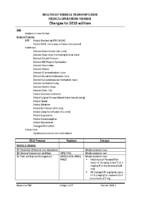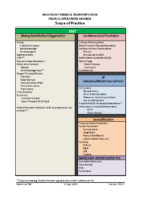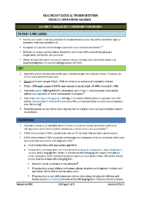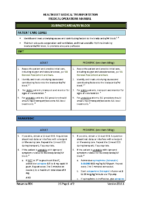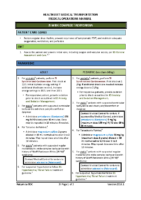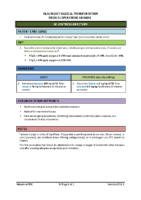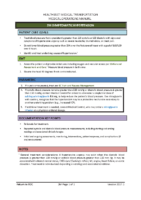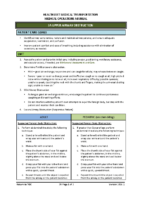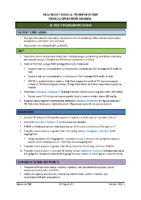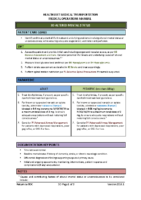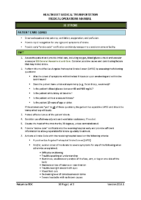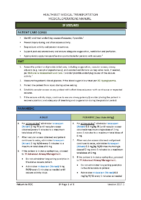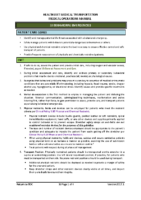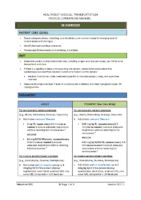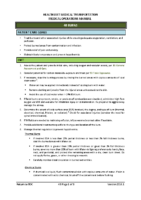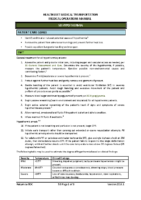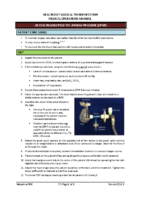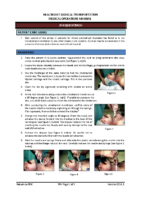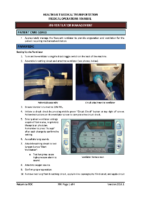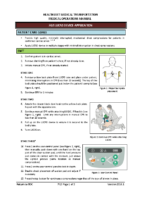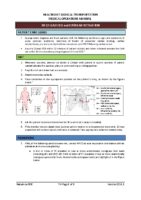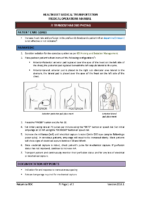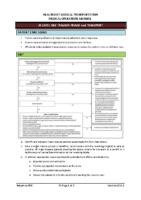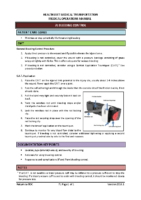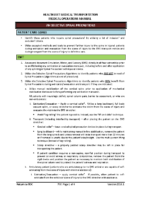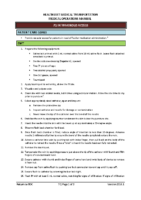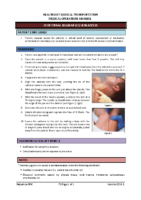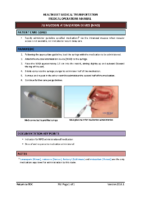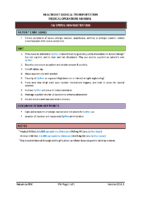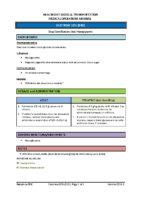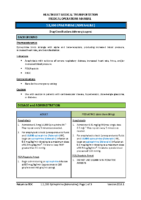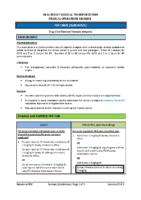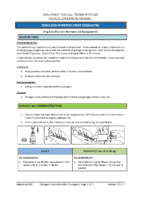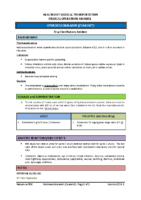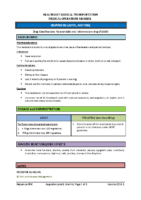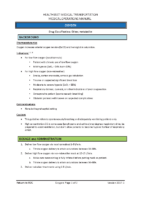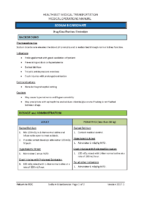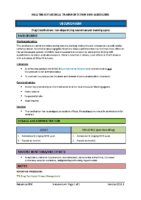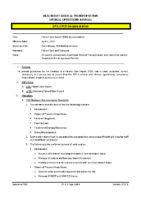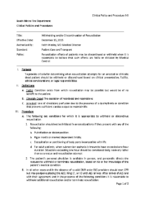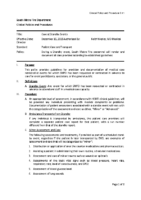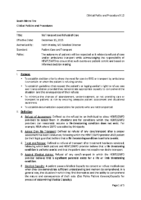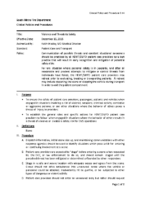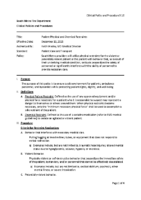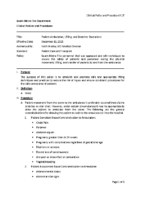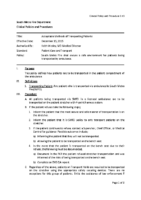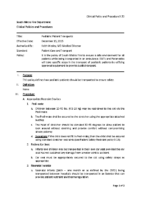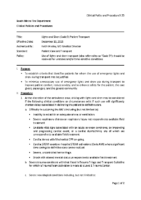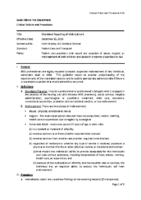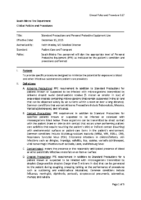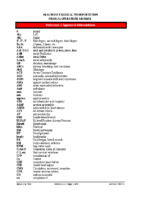EMS Guidelines
1. Preface
2. Changes in version 2016.1
3. Scope of Practice
Section 1: General
1A Overview of Patient Care Guidelines
1B General Assessment and Care
1C Pain and Nausea Management
1D Anxiety and Sedation Management
Section 2: Cardiac
2A Chest Pain/Acute Coronary Syndrome (ACS)
2B Cardiac Arrest Management
2C Ventricular Fibrillation/Pulseless V-Tach
2D PEA/Asystole
2E Hyperkalemic Arrest
2F Post-Arrest Management
2G Bradycardia/Heart Block
2H Paroxysmal Supraventricular Tachycardia (PSVT)
2I Wide Complex Tachycardia
2J Atrial Fib/Flutter
2K Ventricular Ectopy
2L Cardiogenic Shock
2M Symptomatic Hypertension
Section 3: Medical
3A Upper Airway Obstruction
3B Asthma, COPD, and Bronchospasm
3C Acute Pulmonary Edema
3D Altered Mental Status
3E Stroke
3F Seizures
3G Hypoglycemia
3H Hyperglycemia
3I Sepsis/Septic Shock
3J Behavioral Emergencies
3K Overdose
3L Gastrointestinal Emergencies
Section 4: Trauma
4A Trauma Care
4B Burns
4C Eye Injuries
4D Submersion Trauma
4E Nosebleed
4F Taser and Chemical Irritants
Section 5: Environmental
5A Allergic Reaction/Anaphylaxis
5B Hypothermia
5C Hyperthermia
5D Toxic Exposure
Section 6: Obstetrics
6A Normal Labor and Delivery
6B Complications of Labor and Delivery
6C Neonatal Resuscitation
6D Complications of Pregnancy
6E Trauma in Pregnancy
Section 7: Procedures
7A Nasopharyngeal Airway
7B Oropharyngeal Airway
7C Bag Valve Mask
7D CPAP
7E Supraglottic Airway
7F Advanced Airway Management
7F1 DFAM
7F2 Direct Laryngoscopy
7F3 Video Laryngoscopy
7F4 Quicktrach
7F5 Needle Cricothyrotomy
7F6 Ventilator Management
7G Pit Crew CPR
7G1 ResQPOD
7G2 LUCAS Device Application
7H 12-Lead ECG and Cath Lab Activation
7I Transcutaneous Pacing
7J Synchronized Cardioversion
7K Level One Trauma Triage and Transport
7L Bleeding Control
7M Selective Spinal Precautions
7N Kendrick Extrication Device (K.E.D.)
7O Splinting
7P Chest Decompression
7Q Intravenous (IV) Access
7R Intraosseous (IO) Access
7S External Jugular (EJ) Access
7T Medication Administration Cross Check
7U Intranasal (IN) Medication Administration
7V Nebulized Medication Administration
7W EpiPen Administration
7X Glucometry
7Y Helmet and Athletic Equipment Removal
Section 8: Medications
Acetaminophen (Tylenol)
Adenosine (Adenocard)
Albuterol (Proventil)
Amiodarone (Cordarone)
Aspirin
Atropine
Calcium Chloride/Calcium Gluconate
Dextrose 10% (D10)
Diltiazem (Cardizem)
Diphenhydramine (Benadryl)
Dopamine (Inotropin)
Droperidol (Inapsine)
1:1,000 Epinephrine (Adrenalin)
Epinephrine (Adrenalin) 1:10,000
EpiPen & EpiPen Jr.
Etomidate (Amidate)
Fentanyl (Sublimaze)
Glucagon Hydrochloride (Glucagon)
Haloperidol (Haldol)
Hydroxocobalamin (CyanoKit)
Ibuprofen (Advil, Motrin)
Ipratropium Bromide/Albuterol (Duoneb)
Ketorolac (Toradol)
Lidocaine
Lorazepam (Ativan)
Magnesium Sulfate
Methylprednisolone (Solu-Medrol)
Midazolam (Versed)
Morphine Sulfate
Naloxone (Narcan)
Nitroglycerin, Infusion
Nitroglycerin, Sublingual
Norepinephrine (Levophed)
Ondansetron (Zofran)
Oral glucose (Glutose)
Oxygen
Oxymetazoline (Afrin)
Pancuronium
Phenylephrine (Neo-Synephrine)
Propofol (Diprivan)
Racemic Epinephrine
Rocuronium
Sodium Bicarbonate
Succinylcholine (Anectine)
Vecuronium (Norcuron)
Verapamil (Calan)
Section 9: Clinical Policies
9.0 Patient Defined
9.1 Patient Consent
9.2 Medical Control
9.3 Patient Care Report (PCR) Documentation
9.4 Clinical Incident Reporting
9.5 Medication Administration and Safety
9.6 Provider Responsible for Patient Care
9.7 Physician on Scene
9.8 Withholding and/or Discontinuation of Resuscitation
9.9 Do Not Resuscitate (DNR) and Do Not Intubate (DNI) Patient Care
9.10 Hazardous Materials and Environments
9.11 Care at Standby Events
9.12 No Transport and Refusal of Care
9.13 Crime Scenes and Prisoner Transport
9.14 Violence and Threats to Safety
9.15 Voluntary and Involuntary Patient Transport
9.15b: Emergency Hold Form
9.16 Patient Physical and Chemical Restraints
9.17 Patient Ambulation, Lifting, and Stretcher Operations
9.18 Patient Safety Restraints (seat belts)
9.19 Acceptable Methods of Transporting Patients
9.20 Pediatric Patient Transports
9.21 BLS versus ALS Transport
9.22 Family Members Accompanying Patient in the Ambulance
9.23 Lights and Siren (Code 3) Patient Transport
9.24 Hospital Destination Determination
9.25 Safe Place for Newborns
9.26 Mandated Reporting of Maltreatment
9.27 Standard Precautions and Personal Protective Equipment Use
Section 10: Reference Guides
Reference 1 Approved Abbreviations
Reference 2 Body Surface Area Chart
Reference 3 Coma Scales
Reference 4 Normal Lab Values
Reference 5 Common Prescription Medications
Reference 6 Handtevy Guidelines
Reference 7 Pediatric Assessment Tools
Reference 8 Stroke Scales
Reference 9 START Triage
Reference 10 Medication Administration Cross Check (MACC)


